Posts in Category: Uncategorized
My first invitation to speak and what I said
 Last Friday I had the opportunity to attend and speak at a symposium for the Faith Inclusion Network of Dallas (FIND). The symposium was entitled “Weaving Inclusion into our Faith Communities.” Excellent topic…not awareness or tolerance, but INCLUSION. So many people identify themselves though their faith and, regardless of how devout they are, many people look to their faith communities for socializing, school and resources. I loved the idea of devoting a few days to the discussion of really integrating people with all kinds of disabilities into the mix. It’s not enough to put a wheelchair ramp outside or a puzzle-piece sticker on a window. Through the lectures I heard and discussions that were held, I learned that people (both the disabled and the able-bodied) need a lot more information and practice being comfortable with each other.
Last Friday I had the opportunity to attend and speak at a symposium for the Faith Inclusion Network of Dallas (FIND). The symposium was entitled “Weaving Inclusion into our Faith Communities.” Excellent topic…not awareness or tolerance, but INCLUSION. So many people identify themselves though their faith and, regardless of how devout they are, many people look to their faith communities for socializing, school and resources. I loved the idea of devoting a few days to the discussion of really integrating people with all kinds of disabilities into the mix. It’s not enough to put a wheelchair ramp outside or a puzzle-piece sticker on a window. Through the lectures I heard and discussions that were held, I learned that people (both the disabled and the able-bodied) need a lot more information and practice being comfortable with each other.
The topic that I was asked to speak on was “Weaving Valuable Supports for the Parenting Experience.” The organizer of the event (Julie) used to be the admissions director at a school that Gray once attended. We applied 3 years in a row before Gray was accepted into their program and Julie told me that she always admired the way that I was completely honest about Gray’s abilities and challenges. She said that many parents were not completely truthful in their child’s level of need and it made things difficult for the school to evaluate the educational goals. She also said that she admired my ability to accept rejection gracefully when Gray was not admitted to the school the first two times. I know that rejection of your child from a school program just means that he is not appropriate for the services they are offering at that moment. Apparently, many other parents just view that as rejection of their child for being the person that they are. She wanted me to speak to the group about the value of really knowing your kid, being transparent about things and being diplomatic while advocating for your child.
For me, these things have come fairly naturally. The young moms’ group that I have grown with is primarily physical or occupational therapists like myself. All of my friends were comfortable with disabilities on a professional level just like me. I remember one playgroup early-on when we were meeting at my friend Sandra’s house. Her daughter became very alarmed when she discovered Gray chewing on the head of one of her Barbie dolls. Sandra just calmly took the doll from Gray and gave him some other toy that would weather the chewing a bit better and told her daughter that everyone likes to play with toys in different ways. Some people like to dress them up and some people like to chew on their squishy heads. Her daughter immediately calmed down and went to wash her Barbie. Now, years later, her daughters often ask about how “Baby Gray” is doing in his therapies and when he might like to come play again. Because of her attitude and the attitude of all my friends, their children are quite comfortable around Gray and his strange behavior. As a result, I have never felt inclined to hide Gray or his behavior from anyone. I am not ashamed of him and I know that people won’t be comfortable with him unless they know what to expect. Of course, I have mentioned before that I might limit the places we went with him or the houses we would visit based on my assessment of the level of civility required; but I would never have thought to limit information that I would share with professional educators or community groups.
So, holed up in a conference room at Barry’s office one evening, Barry stood at a white board with a marker ready to go. What did I want to say to my audience? How could I tell parents and clergy and program managers the best way to support the parenting experience? A radical idea came to me: labeling.
It seems to me that our current obsession to avoid labels is causing some real problems in the special needs community. I recently heard Temple Grandin speak on a radio show and she said that it gets her really upset when someone is introduced to her as “autistic.” Her point is that people are so much more than their diagnosis might reveal. I agree with her on that, but I’m afraid that message has gotten conflated with the idea that denying someone’s diagnosis or hiding it is ok. Especially in the realm of seeking help, I believe that labeling is incredibly useful for everyone involved. For a parent who is worried about their child, a diagnosis can provide some guidance on topics to research and specialists to consult. For a person in the general public who might be uncomfortable or shocked by a kid who is behaving bizarrely (like pulling their hair, or throwing a tantrum or stealing food off of someone’s plate), giving a label can change a moment of anger into a moment of compassion. And, for a person in a position to educate or care for a child a label (along with lots of specific details) can make the difference between providing meaningful help and a lot of frustration.
I really hope that I didn’t come across as preachy (ironic in a faith community talk, I know) or gave the impression that I have this all figured out. But, I have been told time and time again that the quality of care that Gray receives is a direct result of my willingness to accept the situation and be completely transparent about what he needs. For the parents, I hope to offer advice. For the helpers, I hope to offer some insight. I hope that the following information was helpful to my small crowd.
Here are the main points I tried to get across:
1. Accept the label. A label does not change who the person is. A label does not limit the potential of who the person can be. A label does not encompass all that a person is, but it is a good place to start in organizing expectations of others.
2. Say the label out loud to others. Shame – and not the label – creates the limits for your child. If you can’t go out to restaurants or public pools or birthday parties because you don’t want others to see, then shame (not autism) is ruining your life. The world is full of people with kind hearts and a willingness to help. If you stay inside or pretend that nothing is wrong, no one can help you. I am a big fan of the famed shame-researcher Brené Brown. I think this quote sums up what I’m trying to say. Just replace the word “story” with “label.”
“Owning our story can be hard but not nearly as difficult as spending our lives running from it. Embracing our vulnerabilities is risky but not nearly as dangerous as giving up on love and belonging and joy—the experiences that make us the most vulnerable. Only when we are brave enough to explore the darkness will we discover the infinite power of our light.”
― Brené Brown
3. Receive the assistance that is already out there. Autism awareness and compassion are very helpful when you are on a hellish flight or enduring a tantrum in a restaurant, but you have to be more proactive to get real help. The real help is waiting for you, but only if you go looking for it and are willing to be completely honest with what you need. What is the goal you are working towards? If your answer is, “to make my kid normal” or “to have the life I planned before I became a special needs parent,” then you are on the wrong track. Go back to step 1. It’s time for some acceptance of the situation and the goal needs to be for EVERYONE in the family to live a good life at their highest potential. If you can embrace that concept, then you can look at the specific things that are preventing you or your spouse or your other kids from doing what makes you happy. Here are some examples of services that can help:
* Therapy – Make sure and share your goals with your therapist so that they can work on things that are functional and helpful to YOUR family. Field trips can be very helpful in learning techniques to navigate the community.
* Medicine – This can be a tough one to accept. But, everyone needs some peace and a child who is awake all night or screaming and destructive all day is not good for anyone’s mental health. As my husband said when we finally decided to get some medication for Gray, “We are not leaving this office until one of us has a prescription!” Unfortunately, the tranquilizer blow-darts are not yet on the market for kids with autism.
* Assistive Technology (or Service Animals!) – This one was also easy for me given my background. But, I know a lot of parents who resist getting a communication device for their kid because they worry that it will diminish the likelihood that they will every speak. Not true. Many studies have shown that kids with language disorders will learn achieve a higher potential for speech if they are able to experience the value of communication through an assistive device. Besides, according to typical kids I’ve interviewed: a kid who doesn’t speak is weird, but a kid who uses and iPad to speak is SUPER COOL. Likewise, a service animal like Hope can be truly life-changing. Of course, you have to be ready to embrace Step 2. I leave the house everyday with my kid strapped to a dog that wears a sign announcing his disability.
* Schools – It is incredibly important to find the right fit when it comes to selecting the program that will educate your child. You don’t want to shove your kid in somewhere that isn’t right for them just because you heard it was a stellar school. Stellar to one family can be a nightmare to another. And, once you are in, it is even more important to have open communication with the people who are working with your child. Don’t leave it to them to figure out the needs and address them.
* Long Term Care – This is another tough area. Depending on the severity of your situation, you may or may not need to consider this. But, if you can take some time to imagine the long-range future options for your child, you can be better at setting goals right now.
* Financial Planning – In Texas, kids who have an autism diagnosis are entitled to many insurance benefits that are denied to kids without a diagnosis. Getting a label can be worthwhile if it keeps you from going bankrupt. Also, there are Medicaid Waiver programs and other financial benefits that have long wait lists. It’s better to get your kid on the list and hope that they won’t need it when their name comes up than to look up 10 years from now and realize that you could really use a program that has a 10 year waiting list.
* Advocate without being adversarial. I’ve written about this before. Click the link if you care to read my thoughts.
After the conference was over, Barry and I went home and started getting the kids ready for Night Owls. That is a respite program at a local church that offers a parents-night-out for kids with special needs and their siblings. My kids all love it there. Last Friday they had a carnival. It may have taken 2 grown-ups to keep Gray in check, but they did it with a smile on their face and Barry and I enjoyed a date night knowing that our kids were happy and safe. Of course, in order to get on the wait list for that program, you have to fill in the line that says “Diagnosis.”
Never a dull moment
 Thursday afternoon at 2:15pm, I received a call from Gray’s school.
Thursday afternoon at 2:15pm, I received a call from Gray’s school.
It was actually the second call I had received that day. The first one came earlier in the morning when his teacher phoned to let me know that Gray had derailed her entire lesson plan with his iPad. She went on to explain that she had been working with some students when the song “Do you wanna build a snowman” from the movie, Frozen, started ringing through the classroom. Everyone stopped dead in their tracks and looked to see where the music was coming from. Gray was watching a video on his iPad that Zoe and Lena had made the night before.
Zoe has an app that allows her to take any songs that we own on iTunes and turn them into music videos with effects. Wednesday night, the girls had talked me into participating in their music video because, as they explained, Anna (the little sister in the movie) is 3 different ages throughout the song. Lena was playing the youngest version, then Zoe played the older one and they needed me to play the oldest version of Anna. I reluctantly obliged and followed all of their directions to “really show emotion” and “act out all of Anna’s words” for the camera. Best of all, they started my part off during the instrumental interlude, so the video has a long section where all that is shown is my backside as I stand in front of a door and wait for my cue. The girls thought it was great fun and I was just trying to be a fun-loving mom, but I didn’t consider who else might see the video. I certainly didn’t realize that it was on Gray’s iPad or that he knew where to find it. But, he did. And his whole class had a ball watching with him. Very embarassing.
So, when the second call came in at 2:15, I thought I was just going to take some more teasing over Gray’s non-stop viewing of the video. Imagine my surprise when the call was from Gray’s aide informing me that he had just dislocated his shoulder. He had been sitting in his chair with his feet crossed and leaned too far forward to get up. He lost his balance and caught his arm on a desk as he went to the ground. This caused his right shoulder to hyperextend and pop out of the socket. Sounds horrible, right? Well, his aide saw the whole thing and rushed over to get Gray. He said that he could tell the shoulder was dislocated as soon as he got to him. He tried to immobilize Gray’s arm while the classroom aide ran for the school nurse. Gray, seemingly unfazed by the whole thing didn’t even cry. He just let out a soft whimper and whipped his trunk around while his aide held his arm. This motion caused the shoulder to pop back into the socket and the whole situation was remedied by the time the nurse arrived. Gray has such a high pain tolerance, I suspect he only saw the event as an inconvenient moment when he couldn’t use his arm. I honestly think the only horrible part was for the aide who had to feel and hear all of the joint contortions happening in Gray’s body. By the time I got to the school, Gray was happy and moving his arm normally. The only evidence that any injury had happened was a red spot on top of his shoulder.
Of course, as a matter of safety, I took him to an orthopedic doctor to make sure that everything looked to be in its proper place. Ironically, Gray was the most calm and peaceful kid in my group. I nearly killed Zoe and Lena for goofing around and fighting throughout the entire appointment. Even while the doctor was talking to me and assuring me that everything looked fine, the girls were fighting over my phone and Gray’s iPad and who could climb on the exam table. I was furious and rattled by the time we left, but not because of Gray’s injury. It was because of the girls’ behavior and the fact that we were leaving the doctor’s office at 6pm and I had nothing prepared for dinner and everyone was starving. Funny, right? No one was was terribly upset or worried over Gray’s shoulder…not even Gray.
That’s how we roll in the Golden family. I wonder if it is that way for other families impacted by autism? Gray’s muscle tone is so low and his joints are so lax that I’m actually surprised he hasn’t dislocated more joints. Additionally, it seems that there is always some kind of medical emergency popping up for Gray. He has had stitches, glue and staples to mend cuts and gashes. Most days, he is sporting a bruise from some unknown source – either a fall or a self-inflicted punch or just running into things. Even when he had a full-blown seizure while we were on vacation in the Caribbean two years ago, we all just took it in stride. Of course Caribbean hospitals are much less beautiful than the resorts, but we were back on track 24-hours later. I remember a girlfriend asking me if I freaked out when Gray started with the convulsions. I replied, “No, not really. I knew what was happening. If one of the girls had a seizure, I would freak out. But, with Gray, there is always some new emergency cropping up.”
I don’t mean to sound callous towards my precious son, but the truth is, it is getting hard for him to shock me at this point. Even the girls could resume their normal bickering while we waited for Gray’s x-rays to come back. I credit him with a lot of my cool-headed handling of situations. It seems that many parents I know are way too overprotective of their kids. They worry about their kids playing outside with no shoes, eating too many sugary snacks, and signing up for plenty of extracurricular activities to keep them well-rounded. Not me. My low standards keep my sanity intact. I figure that a day without any visits to the emergency room is a good one.
Snow Day
 Sunday night, I received a text message from Lena’s school stating that it would be closed on Monday due to the weather. I quickly jumped on the Dallas ISD page and discovered that school was cancelled for all of my children. I gulped hard. A small flutter of panic rose into my throat. I have endured snow days in the past with everyone home and it wasn’t pretty or peaceful or restful, it was hell.
Sunday night, I received a text message from Lena’s school stating that it would be closed on Monday due to the weather. I quickly jumped on the Dallas ISD page and discovered that school was cancelled for all of my children. I gulped hard. A small flutter of panic rose into my throat. I have endured snow days in the past with everyone home and it wasn’t pretty or peaceful or restful, it was hell.
Two years ago, we had a terrible ice storm hit Dallas and the city shut down for almost a week. Gray did not understand why we weren’t carrying on with our usual routines and stood at the door screaming. When the girls got bundled up to go play outside, Gray ran to join them. Of course, Gray was unable to tolerate a hat on his head or gloves on his hands, so playing outside proved even more frustrating than staying inside. As his hands turned bright red in the cold, he just stood there and screamed while little frozen tears dried on his cheeks. The only thing I could do to entertain him was to spin him in a chair or feed him goldfish crackers. By the third day, Gray was beating his head against the doors and windows in pure frustration over cabin fever. I would have felt sorry for him, but honestly, I was too busy feeling sorry for myself. I was willing to risk both my life and his by simply going out and driving around the city. I lived in the Northeast for a few years and learned to drive on slippery roads, so I felt like I could handle it. Of course, I couldn’t actually stop anywhere or patronize any open businesses because Gray would have been unmanageable and I could only imagine the carnage if he tried to elope and one of us slipped and fell during the chase.
Sunday night, as I felt that old familiar feeling of dread, I tried to reassure myself that things are different now. I went to sleep praying that the roads would not completely glaze over and we could go out for a bit. I recently read an article that admonished parents for complaining about snow days. The author reminded adult readers about the thrilling feeling that kids get when school is unexpectedly cancelled and the negative message that we send our kids when we look disappointed about having to spend the day with them. I resolved not to be that mom. I awoke Monday morning to find Zoe standing in front of me with her school uniform. She looked puzzled as to why I was still in bed at 7:30am. When I told her that school was cancelled, her whole face lit up. When I realized that Gray was sleeping late that morning, I thought that it was a good omen for a peaceful day ahead. After a leisurely breakfast, I decided that we would venture out to accomplish a few errands. The girls were so happy to have an unplanned day off that they eagerly agreed to whatever I wanted.
Thankfully, the roads were quite clear. We made a few quick stops before heading into the craft store to replenish our supplies for the afternoon ahead. I smiled to myself because I had a little flashback of the nightmare shopping trips that I reference in my post, entitled Shopping at Target, where Gray humiliated me when he pinched a man and threw his shoe at a woman. I knew that today would be different.
While the girls were fluctuating between excitement and argument with each other, Gray was calm and happy. The girls were jumping out of the car and slipping around in the parking lot, but Gray exited the vehicle quietly and steadied himself with Hope’s handle. We entered the store in an orderly fashion and pulled a cart from the front. While the girls ran around and fought over which crafts to buy, Gray walked calmly beside me and helped me push the cart. He only grew agitated when we looped around our 10th aisle and showed no signs of leaving the store…but, I attribute that to general male shopping agitation. I can’t imagine a typical 8-year-old boy tolerating a trip to the craft store as long as Gray did.
From the craft store, we headed to Central Market, a gourmet grocery store with samples galore. Usually, I am on a mission at the grocery store with a long list and limited time. But, today was a snow day. THIS was our entertainment. With time on our hands, we slowly meandered through the store and stopped every time we saw a sample that appealed to us or an item that we wanted to try at home. Gray got equal billing in the choice-making. Through his iPad and pointing, we made as many stops per his requests as we did for anyone else’s. The result? $100 worth of novelty groceries, 2 hours killed, lunch-via-samples and no melt-downs.
Arriving back home at 3pm, I felt very pleased with the day. Everyone had a good time, including me. It was the first snow day that I have enjoyed since I was a kid. But, then again, life is pretty enjoyable overall these days.

What a year
 February 2nd marked the one-year anniversary for Hope’s introduction into our home. That was the time that everything really started changing for our family. As I look back over my posts from that week(Re-entry and First Family Outing,) I am amazed at how far we have come. I am proud of all of us for sinking into this new reality whole-heartedly. It has clearly paid off. When people ask me about Hope and say, “So, has the service dog made a difference for your son and your family?” I have to smile. My answer is, “It has made our whole life better.”
February 2nd marked the one-year anniversary for Hope’s introduction into our home. That was the time that everything really started changing for our family. As I look back over my posts from that week(Re-entry and First Family Outing,) I am amazed at how far we have come. I am proud of all of us for sinking into this new reality whole-heartedly. It has clearly paid off. When people ask me about Hope and say, “So, has the service dog made a difference for your son and your family?” I have to smile. My answer is, “It has made our whole life better.”
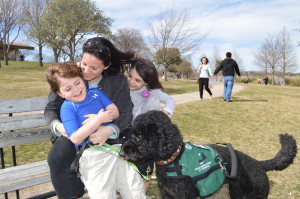 Things could not be more different now than they were a year ago. In a nutshell, Gray is a better boy with Hope by his side. In all honesty, my original goal in getting a service dog was just to tie an anchor around my crazy kid so that he couldn’t run out into traffic or disappear into a crowd. That was it. Yes, I had some other far-fetched ideas about what this magical dog might do for Gray, but in reality, I was just hoping for an anchor. In fact, Barry and I had more than one conversation where we wondered if we might get the same effect if we tethered Gray to one of us. It sounds ridiculous, but at the time, we really didn’t understand what difference it made who Gray was tied to.
Things could not be more different now than they were a year ago. In a nutshell, Gray is a better boy with Hope by his side. In all honesty, my original goal in getting a service dog was just to tie an anchor around my crazy kid so that he couldn’t run out into traffic or disappear into a crowd. That was it. Yes, I had some other far-fetched ideas about what this magical dog might do for Gray, but in reality, I was just hoping for an anchor. In fact, Barry and I had more than one conversation where we wondered if we might get the same effect if we tethered Gray to one of us. It sounds ridiculous, but at the time, we really didn’t understand what difference it made who Gray was tied to.
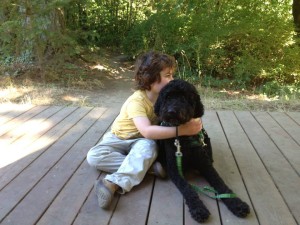
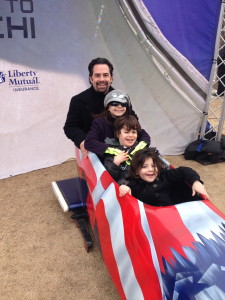 Now, a year later, I have a better grasp on what Hope really means to Gray. She means security and direction to a boy who never understood where he was supposed to be. Where we saw a kid who just wanted to RUN, I now understand that he was really a kid who was constantly in search…of what, I don’t think he knew. Before, when people would ask me why it was hard to take Gray out in public, I would describe a scene where Gray was constantly trying to run away from us, one of us would grab or chase him, and Gray would end up having a meltdown on the ground. I truly didn’t believe that he had the capacity to stay with us or participate in our outings; thus, the need for an anchor.
Now, a year later, I have a better grasp on what Hope really means to Gray. She means security and direction to a boy who never understood where he was supposed to be. Where we saw a kid who just wanted to RUN, I now understand that he was really a kid who was constantly in search…of what, I don’t think he knew. Before, when people would ask me why it was hard to take Gray out in public, I would describe a scene where Gray was constantly trying to run away from us, one of us would grab or chase him, and Gray would end up having a meltdown on the ground. I truly didn’t believe that he had the capacity to stay with us or participate in our outings; thus, the need for an anchor.
Of course, it only took a short time for Gray to understand what Hope could do for him. Within a couple of months, the tether just became a safety strap because Gray no longer tried to pull away. Walking next to Hope and holding his handle, Gray is relaxed and comfortable out in public. He is no longer searching. Hope is the constant in Gray’s life that follows him to all of the places that his people cannot. Whether he is at school or home or the park or on an airplane, Hope is with him and Gray knows he is just where he should be. I think that is a tremendous relief to a boy who spent the first 6 years of his life unsure of his surroundings or the expectations for his behavior outside of a therapy setting.

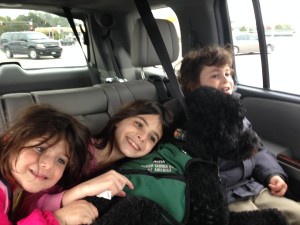 This new, stable mental state has allowed us to reduce his need for medications and increase his goals for both functional and academic skills. Over the last year, I feel like we have really gotten to learn more about Gray’s personality…aside from his autism. Gray is a sweet and happy boy who likes to get out and see the world. Just like me, he doesn’t like being isolated or cooped up at home. He is always up for an outing, and going out to eat is the quickest way to cure a foul mood. When we are out and enjoying a family afternoon, he will often reach for Zoe or Lena and give them a big squeeze and a kiss. Both girls have learned to walk next to him in an affectionate headlock. Likewise, his newfound patience has allowed him to communicate better. He has learned that we will all stop and let him have time to use his iPad when he needs to say something. He has learned that we are his people and he can trust us to meet his needs.
This new, stable mental state has allowed us to reduce his need for medications and increase his goals for both functional and academic skills. Over the last year, I feel like we have really gotten to learn more about Gray’s personality…aside from his autism. Gray is a sweet and happy boy who likes to get out and see the world. Just like me, he doesn’t like being isolated or cooped up at home. He is always up for an outing, and going out to eat is the quickest way to cure a foul mood. When we are out and enjoying a family afternoon, he will often reach for Zoe or Lena and give them a big squeeze and a kiss. Both girls have learned to walk next to him in an affectionate headlock. Likewise, his newfound patience has allowed him to communicate better. He has learned that we will all stop and let him have time to use his iPad when he needs to say something. He has learned that we are his people and he can trust us to meet his needs.
 Additionally, I feel like I have found my voice through my recording of this journey. I have something to say to people who have no experience with kids like Gray. I want to tell them that he is just a kid who wants to do kid things. It might take a lot more effort for him, but getting to know kids like Gray will make you a better person. I promise. You will be kinder and more patient and more grateful for your own life. Your heart will swell when something you do contributes to the pure joy that comes from a kid who is not entitled, but works hard in every aspect of his life. As one person recently told me after spending way more time at our house than she intended, “That smile just sucks you in!”
Additionally, I feel like I have found my voice through my recording of this journey. I have something to say to people who have no experience with kids like Gray. I want to tell them that he is just a kid who wants to do kid things. It might take a lot more effort for him, but getting to know kids like Gray will make you a better person. I promise. You will be kinder and more patient and more grateful for your own life. Your heart will swell when something you do contributes to the pure joy that comes from a kid who is not entitled, but works hard in every aspect of his life. As one person recently told me after spending way more time at our house than she intended, “That smile just sucks you in!”
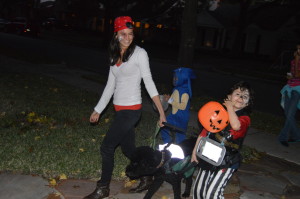 I also have much to say to other parents of children with autism. It is up to us to allow our children to reach their full potential. While therapy to improve on behavior and speech and fine motor skills is important, it is equally important to meet your kid where they are. Imagine parenting a typical child where the overall message to them is “you’re abnormal, disgusting, embarrassing and not fit for the general public.” For typical kids, that would be considered child abuse. For kids with autism, whether intentional or not, that message is very common. With the newest studies showing that autism has now reached an incidence of 1 in 36 children, it is time to realize that the population is going to look very different in 20 or 30 years. We all need to work together to make a community that accepts these kids and young adults as they are and helps them find their place in world. We can’t expect our kids to learn how to properly behave in the community if we restrict their access to the public.
I also have much to say to other parents of children with autism. It is up to us to allow our children to reach their full potential. While therapy to improve on behavior and speech and fine motor skills is important, it is equally important to meet your kid where they are. Imagine parenting a typical child where the overall message to them is “you’re abnormal, disgusting, embarrassing and not fit for the general public.” For typical kids, that would be considered child abuse. For kids with autism, whether intentional or not, that message is very common. With the newest studies showing that autism has now reached an incidence of 1 in 36 children, it is time to realize that the population is going to look very different in 20 or 30 years. We all need to work together to make a community that accepts these kids and young adults as they are and helps them find their place in world. We can’t expect our kids to learn how to properly behave in the community if we restrict their access to the public.
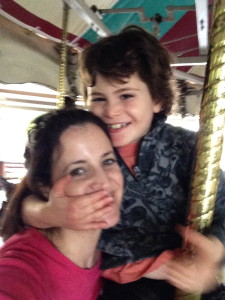
 More than anything, this year has been a gift to me and my family. Having a child with special needs makes you look at life in a different way. You become envious of “normal” families and their easy lives. It can be easy to wallow in self-pity over the things that you are missing out on. Now, I don’t feel that way anymore. Truly. When we want to go out to eat or make weekend plans, I don’t even consider Gray’s behavior any more than I consider Lena or Zoe. Hope is a miracle, and the people who contributed to her training and selection for our family are real-life angels. I don’t know what the next year has in store for Gray or our family, but I can tell you that my goals have been set much higher!
More than anything, this year has been a gift to me and my family. Having a child with special needs makes you look at life in a different way. You become envious of “normal” families and their easy lives. It can be easy to wallow in self-pity over the things that you are missing out on. Now, I don’t feel that way anymore. Truly. When we want to go out to eat or make weekend plans, I don’t even consider Gray’s behavior any more than I consider Lena or Zoe. Hope is a miracle, and the people who contributed to her training and selection for our family are real-life angels. I don’t know what the next year has in store for Gray or our family, but I can tell you that my goals have been set much higher!
In Print Again!
Another Dallas magazine, Thrive, decided to write an article on Gray and Hope with Advocacy as the focus. While some of the details about timing are not quite right, I think this author was able to capture my thoughts about getting help in achieving good outcomes for my family.
You can view the article on the magazine’s website here: Thrive Magazine Article
The Good Fight
By Dawn McMullan
Last February, Rhoni Golden wrote down three goals for her family, centering on her 7-year-old son Gray and the autism service dog she was about to meet:
1. Gray needs to be potty-trained.
2. Gray needs to stop disrupting our family with his tantrums and hyper-manic episodes. It makes him miserable, and it makes everyone around him miserable.
3. We need to be able to go out in public as a family without the fear of Gray running away into a dangerous situation. We deserve to go visit friends or walk around the mall or check out a street festival like other families do.
“If this works,” she wrote in her blog, Hope for Gray (hopeforgray.com), “life is about to get REALLY good.”
Fast-forward almost a year to the Goldens’ lives with Hope, the service dog she was on her way to meet. Hope is the first service dog to be allowed into a Dallas ISD school. With Hope in their lives, the family of five – including 10-year-old Zoe and 4-year-old Lena – goes to the mall, goes to restaurants and travels together (uneventfully). Although Gray still isn’t potty-trained, goals 2 and 3 are celebrated every day.
With Hope in tow, life did get really good. The 50-pound black Labradoodle with soft curls – who loves to nap on her dog bed and play fetch with tennis balls in the backyard when she’s off the clock – changed almost everything about the family’s life.
Life with a service dog
Autism affects one in every 88 children (one in 54 boys) and is the fastest-growing serious development disability in the country, according to Autism Speaks. Although the disability has no cure, families frequently seek therapy, medications and communication tools to ease its effects. About a decade ago, autism service dogs became one such “tool” – still relatively unknown, even by families affected by autism.
Gray Golden is severely autistic, mostly nonverbal and doesn’t understand boundaries like street curbs or a table of strangers at the mall. He communicates through an iPad app. At restaurants, Gray used to run around and steal food off people’s plates. He spent a lot of time being grabbed by his parents and having tantrums on the floor because of it.
Now, such tantrums can be gently quelled with the phrase “get your handle,” directing Gray to take the handle on Hope’s service pack. While Hope is always “on” when she’s wearing her service pack, this action gets Gray into a similarly focused frame of mind. Hope follows her handler’s words, and Gray follows Hope’s lead.
Rhoni and her husband Barry first heard about autism service dogs on the Today show in the fall of 2012. Research led her to the Portland, Oregon-based Autism Service Dogs of America, a nonprofit that trains and places service dogs. A few months later, she was on a plane to Portland. Golden spent a week there training with Hope and Kati Wolfe, placement and training director at ASDA. Wolfe, who grew up having tea parties with her dogs and worked with children with disabilities at her mom’s preschool, has a degree in psychology with a minor in special education (focusing on autism) and is a certified professional dog trainer.
ASDA places seven to 10 dogs each year. When working, the dogs wear a clearly labeled service pack and are all business. At home, they go off-duty and are treated like any other family pet.
Children with autism thrive on predictability and structure. A service dog offers both. “The dogs are a constant in a child’s life, which is huge for autism,” Wolfe says. “I don’t like to call the dogs tools, but in a lot of ways they are. The dog is a tool the child has by their side all the time.”
Most of the dogs Wolfe has placed have gone into schools without issue. As part of the home visit, Wolfe spends three days with the dog at his or her child’s school. “We believe the more the child and the service dog are together, the more the system will work,” she says. “With any system, you’re trying to reach the child through consistency and predictability.”
A human aide, which DISD quickly offered up for Gray, is different from a service dog because that person isn’t constant, Wolfe says. While a school aide is in the classroom, he or she is not at the soccer game, restaurant or on an airplane for the family vacation. Hope is.
Hope goes to school
Hope came to live with the Goldens in their Lakewood Hills home in February 2013. At the time, Gray was going to a private school for children with learning differences. Not believing this particular school was a long-term solution, the Goldens began exploring their options.
At their first ARD (admission, review, dismissal) meeting with DISD, the Goldens explained Gray’s learning and behavioral issues: that he was a hygiene risk (Golden has an entire blog post titled “The Pooptastrophe” if you want the gory details), a flight risk and needed one-on-one attention. At the end of the evaluation, DISD officials said they believed the district could provide an appropriate education, including the one-on-one requirement.
As discussions continued, Golden says, the principal and teachers at the John F. Kennedy Learning Center were enthused about Hope coming to school with Gray. But things took a detour when DISD’s legal department got involved. Parents and schools nationwide have been engaged in similar discussions in recent years, with districts arguing that service dogs do not provide anything a human can’t provide, that offering a handler for the dog is above and beyond their legal mandate and that the dogs are mere companions – not truly medically necessary.
A 7-year-old boy in California named Caleb Ciriack and his dog, Eddy, were one such case. In 2011, a federal judge ruled that Caleb’s school district must allow Eddy, who was trained by ASDA, to come to school.
Barry Golden, an attorney, showed up to the first meeting on the legal issue with the Ciriack case in hand. DISD had never said Hope couldn’t go to school with Gray; the 10-day legal battle centered on who would provide the handler – the Goldens or DISD.
The difference between an autism service dog and, say, a service dog for the sight-impaired is that a severely autistic child like Gray is not cognitively capable of handling the dog, requiring an adult to do so during the school day. The two sides quickly resolved the issue, and Hope came to school with Gray for three days last May (as a trial run for this school year and with Rhoni there to help), returning in August. The school year started off a bit shaky. DISD did provide an aide: a 50-year-old woman who was afraid of dogs. A new aide, however, is working out well, Golden says.
“Sometimes we have to try things that haven’t been done before,” says Jon Dahlander, DISD media supervisor. “In this case, the school and the parents worked together to come up with a plan to benefit the student, and that’s great. Change is difficult for everyone, but we’re on the other side of that.”
The difference Hope makes
Legally, the Goldens weren’t required to explain how a service dog would help Gray. That said, the district did ask what a dog could do that an aide couldn’t. If Gray is having a meltdown, for example, it’s difficult for a person – even a parent – to console or confine him. A person handling Hope, however, can simply click Gray’s belt (which he wears around his waist) into Hope’s service pack and say, “We’re going for a walk.”
“It’s a cue for him,” Golden explains. “He hears that click and before he knows it, he’s standing up, taking her handle and walking out the door. That can take a tantrum from 30 minutes down to two. A person can’t do that.”
Just sitting at his desk at school can be a challenge. But if Gray is attached to Hope, who is in a down-stay position under his desk, he knows he needs to stay put. “There are only so many times an aide can say, ‘Sit down, Gray. Sit down, Gray.’ Then he’s mad. When he’s attached to Hope, he knows,” Golden says. “One of the biggest deficits for people with autism is they don’t see lines of delineation, like this is the sidewalk, that’s the street. They don’t have any kind of boundaries about where they’re supposed to be.”
That causes stress. With a service dog, kids like Gray know where they’re supposed to be: with their dog.
When Gray outgrew his stroller, taking him out in public was almost always a disaster, usually ending in multiple apologies. Sitting at NorthPark Mall, 10-year-old Zoe giggled while enjoying lunch from Sonic with her mom, her two siblings and Hope. She described how Gray used to be manic in public – “laughing like a madman, pinching, jumping, bouncing off walls literally.”
You can tell she’s still excited about what most families take for granted. “For us all to go out, that would be the craziest thing in the world,” Zoe says. “But now, it’s just normal.”
“It’s way more than I thought it would be,” Golden says of bringing Hope into the family. “I really thought all it would be was tying an anchor around his waist. That would be helpful enough. I didn’t know it would change his attitude about the world, that he’d be a calmer kid overall. But really, truly, it has done all of that.
“We’re living life. There are five of us in this family. Now it’s not an uphill battle all the time.”
Published February 2014
Sidebar
Rhoni and Barry Golden went from viewing a TV segment on autism service dogs to getting a dog in their home within 15 months. Obviously, Gray is lucky to have such advocates looking out for him. “No one else is going to advocate for your child with the same passion that you feel,” Rhoni Golden says. “Believe in your child’s future and fight for it.” Golden offers this advice for advocating for your child:
• Be discerning. Only professionals who are passionate about their career may work with my son. My son needs people who are deeply committed to understanding and helping him.
• Keep a list. I often make lists of questions or wish lists of skills that would improve life for my family. Then I can decide which are the best people to share these questions and requests with.
• Keep everyone in communication. I try my best to keep all members of Gray’s treatment and educational team in contact with one another.
• Know your rights in the school system. Under federal law, all children have a right to a free and appropriate public education. Don’t be afraid to ask for more than they offer. The district’s job is to keep costs down. Your job is to get the best education possible for your child.
• Know your insurance rights. In the state of Texas, children with autism have special protections under House Bill 1919, which prohibits insurance companies from limiting services such as behavioral therapy, speech therapy and occupational therapy. Mistakes in claim processing are common. Don’t hesitate to ask for a supervisor.
• Go with your gut. If you know that the services your child receives are inadequate, speak up.
• Always start out friendly. Most people in the business of helping kids with special needs really do have the best intentions. If you start out winning people over and appreciate what they’ve been doing so far, they are more likely to work with you for the best outcome possible.
Advocacy
Recently, I was asked to contribute to a magazine article about Hope and Gray. As an afterthought, the magazine editor requested that I give information for a sidebar about being a good advocate for your child. It got me thinking that this would be a good topic to talk about on its own.
As a therapist, I constantly found myself in a position to advocate for my patients. On any given day, I could find myself advising patients to report new symptoms to their doctor that they might otherwise think were insignificant; or collaborating with other therapists to decide the best way to tackle a functional problem; or arguing with insurance to cover a piece of equipment that they deemed unnecessary. In my professional life, I was very comfortable speaking up on behalf of my patients. So, as a mother, I was equally comfortable speaking up on behalf of my son. I have often said that I cannot imagine the difficulty that parents without a medical background must have when they find out that their child has autism.
Common though it may be, autism remains a mystery. This is further complicated by the fact that children with autism can vary dramatically in their symptoms, abilities and challenges. So, unlike other medical diagnoses, when a parent receives and autism diagnosis for their child, there isn’t exactly a guidebook as to what the next best steps are. In my case, the doctor just gave me a list of therapy centers that I could contact and said she would see us again in six months. Everything else, I had to figure out on my own. Even finding my way to the doctor that diagnosed Gray was a self-directed journey. I can easily see how other parents can take years to finally get to the same place.
Likewise, the tests, treatments and therapies that are recommended all cost lots of money. Without proper insurance coverage, families can find themselves in deep financial trouble. It is so important to understand your child’s insurance coverage and the laws that your state has in place to protect families like ours. In Texas, there is a state law that requires traditionally funded insurance companies to pay for therapies such as PT, OT, Speech and ABA (applied behavioral analysis) without limits to the annual number of visits that might apply to people without an autism diagnosis. Of course, I have found myself many times calling the insurance company to explain why their processing of my son’s claim is incorrect according to Texas law. If I had no knowledge of the law, I would just accept the determination that Gray was ineligible for further therapy. I would have to choose to pay thousands of dollars out of my own pocket or discontinue therapy.
With this in mind, I embraced the opportunity to share my thoughts on advocacy with the magazine editor. Here is what I gave her:
I believe that all parents of special needs children want to find the best and most helpful services for their kids. For many people, it can feel overwhelming to tackle the medical, educational and financial barriers that get in the way. It is important to remember that you are the person who knows your child best. The recommendations of medical professionals, teachers and insurance providers may or may not be appropriate for your child and your family. Don’t be afraid to ask questions about the reasoning behind recommendations. Don’t be afraid to disagree.
Here are some of my personal guidelines when assessing services for Gray:
– Be discerning. Only professionals who are passionate about their career may work with my son. I want them to love working with children who have autism and I want them to find my son particularly interesting. I have no time or patience for people who are just working for a paycheck and waiting for the weekend. My son needs people who are deeply committed to understanding and helping him. Anything less is a waste of time and money.
– Always start out friendly. Most people in the business of helping kids with special needs really do have the best intentions. If you start out winning people over and appreciate what they have been doing so far, they are more likely to work with you for the best outcome possible. Try not to create “sides” by being adversarial unless it becomes necessary.
– Keep a list. I often make lists of questions or wish lists of skills that would improve life for Gray and my family. It is helpful to have them written down so that they feel real and important. Then, I can decide who are the best people to share these questions and requests with.
– Good communication is key. I try my best to keep all of the members of Gray’s treatment and educational team in contact with one another. Whenever a big transition is coming up, I try to organize meetings where everyone can speak in person. At a minimum, I will connect everyone by email so that they can share opinions and concerns in a collaborative way.
– Know your rights in the school system. Under federal law, all children have a right to a free and APPROPRIATE public education. It is important to make sure that the education plan for your child is appropriate and adequate for their needs and will maximize their abilities to grow and learn. Don’t be afraid to ask for more than they offer. The district’s job is to keep costs down. Your job is to get the best education possible for your child.
– Know your rights with insurance. In the state of Texas, children with autism have special protections under House Bill 1919 that keep insurance companies from limiting services like behavioral therapy, speech therapy and occupational therapy. It is important to know if your insurance company must comply under the laws. Don’t expect the person processing your claims to know the laws. They often don’t. Mistakes in claim processing are common. Don’t hesitate to ask for a supervisor.
– Go with your gut. If you know that the services your child receives are inadequate, speak up. If there is something more you would like to see in your child’s program, you are probably right. No one else is going to advocate for your child with the same passion that you feel. Believe in your child’s future and fight for it.
Theater Dog
 As a parent, I think it is natural to want to introduce your children to experiences that you enjoy. I’m sure we all began parenthood with visions of sharing trips and activities with our kids. Fathers think about playing sports together and mothers think about shopping and manicures. Of course, that is one of the most heartbreaking parts about learning that your child has autism: the future you envisioned just floats away. The big things take a while to let go of. Things like college and marriage and grandchildren are things that you really hope will somehow be possible, but, as time goes on, you start to accept that they likely are not.
As a parent, I think it is natural to want to introduce your children to experiences that you enjoy. I’m sure we all began parenthood with visions of sharing trips and activities with our kids. Fathers think about playing sports together and mothers think about shopping and manicures. Of course, that is one of the most heartbreaking parts about learning that your child has autism: the future you envisioned just floats away. The big things take a while to let go of. Things like college and marriage and grandchildren are things that you really hope will somehow be possible, but, as time goes on, you start to accept that they likely are not.
The smaller day-to-day things are a little easier to accept because you just live with the status quo. You don’t sign up for any sports teams because you know it doesn’t make sense. You don’t sign up for swimming lessons because you think he won’t know how to follow the directions. You stick to fast food restaurants because explaining manners and proper behavior to your child with autism is just too ridiculous to imagine. I think that this is why so many parents of children with autism feel trapped. I’ve often commented to Barry that I feel like we never encounter other kids like Gray outside of therapy settings. His response is that, he believes, most parents of kids like Gray don’t take them out of the house unless it is for therapy or school or to a well-known autism-friendly location. I hate to presume what other parents are doing, but I think he may be right. That brings up the question: If you never take your child out into the community, how will he ever learn how to act?
Of course, I also have two other children who are typically developing little girls. For them, my dreams of bright futures and enjoying experiences together are firmly in place. Even before I was a mother, I knew that I would make it a top priority to teach my children to be good restaurant patrons and theatergoers. Barry and I really enjoy live theater, and a nice meal before or afterwards just makes the event feel special. Starting from infancy, we made a point to bring Zoe out to restaurants with us at least once every week or two. By the time she was four, Zoe had seen a number of plays at the local children’s theater and had a good understanding of proper behavior during a show. We have followed the same path with Lena and, I am happy to say, they are both very nice companions when the show is exciting and the menu has chicken fingers.
I guess all of the experiences with the girls over the years primed me for my mission to include Gray in our activities. All of our successful outings with Hope have shown me that Gray wants to be included. And, his path to learning the rules and expectations of different settings is not so different from typical children. It just takes a little more effort. Children, after all, need to be taught what is expected of them and often require corrections when they slip up. For Gray, I just keep my expectations around the same level as Lena. We talk about events before they happen with the aid of a social story and pictures on his iPad. The first few times we go to a new event, I resign myself to the fact that I am on a business trip with goals and objectives.
This has worked pretty well over the last few months. With Hope by his side, Gray is easier to manage and I am emboldened by our successes to strive for more. So, when I saw that the local children’s theater was putting on a circus show, I thought it might be a perfect opportunity to introduce Gray to live theater. Plays can be tricky. Performers and other audience members could become alarmed if someone starts throwing a fit in the 10th row. Children’s theaters are better, but Gray’s screams are much louder than your average toddler and I have cringed at the possibility of imposing his frustration on people who have paid a lot of money for theater tickets. A circus show, on the other hand, sounded like a show where noisy audience members could be more easily excused.
 When the box office opened on the morning of the show, I called and told the house manager that my family would be bringing a service dog for my son. I’m really glad that I did that because she was so kind and accommodating. She told me that she would reserve some seats for us on the first row of the second section of seats. This would allow plenty of room for Hope to lay at Gray’s feet and it would give us a quick escape route if Gray could not tolerate the performance. Additionally, she gave me a few warnings about the show. She told me that there would be two dog acts in the first half of the performance. I paused for a moment and considered this. Part of Hope’s training includes ignoring other dogs when she is wearing her service pack. The most I have ever seen her do is pop her head up to look at other dogs. I told her that I felt certain Hope would not bark or rush towards the stage. She told me that wasn’t really her worry. She was more concerned by the possibility that one of the stage dogs would see Hope and rush out into the audience. THAT was a funny thing to consider. In all of my ruminations over bringing Gray and Hope to the theater, I never once thought that I needed to be concerned over a stage player abandoning his role to join us in the audience. I told her that, as soon as I saw the dog acts beginning, I would make sure Hope was tucked down flat on the floor to keep her out of view from the stage. Finally, she told me that the end of the first act would feature a group of drummers marching down the aisle in front of us. I thanked her for all of the information and felt better going into the theater with an idea of what to expect.
When the box office opened on the morning of the show, I called and told the house manager that my family would be bringing a service dog for my son. I’m really glad that I did that because she was so kind and accommodating. She told me that she would reserve some seats for us on the first row of the second section of seats. This would allow plenty of room for Hope to lay at Gray’s feet and it would give us a quick escape route if Gray could not tolerate the performance. Additionally, she gave me a few warnings about the show. She told me that there would be two dog acts in the first half of the performance. I paused for a moment and considered this. Part of Hope’s training includes ignoring other dogs when she is wearing her service pack. The most I have ever seen her do is pop her head up to look at other dogs. I told her that I felt certain Hope would not bark or rush towards the stage. She told me that wasn’t really her worry. She was more concerned by the possibility that one of the stage dogs would see Hope and rush out into the audience. THAT was a funny thing to consider. In all of my ruminations over bringing Gray and Hope to the theater, I never once thought that I needed to be concerned over a stage player abandoning his role to join us in the audience. I told her that, as soon as I saw the dog acts beginning, I would make sure Hope was tucked down flat on the floor to keep her out of view from the stage. Finally, she told me that the end of the first act would feature a group of drummers marching down the aisle in front of us. I thanked her for all of the information and felt better going into the theater with an idea of what to expect.
 As for the actual performance, Gray did wonderfully. Like most of our outings these days, Gray tagged along with a happy expectant look on his face. I think that he has learned that, if all five of us are going somewhere, it’s going to be fun. I was grateful to see that his seat was a standard chair as opposed to a flip-up theater seat. Those can be challenging for most kids who struggle against being folded up inside; but for a kid with autism, a moveable seat pretty much guarantees nonstop movement and agitation. Gray climbed into his chair and Hope curled up at his feet and the show was mesmerizing. Barry and I both beamed at the peaceful look on Gray’s face when he watched the acts and enjoyed the music. If I had to guess, I would say that his favorite act was the girl with the hula-hoops who spun them in time to soothing music under purple-blue lights. He was motionless during that act.
As for the actual performance, Gray did wonderfully. Like most of our outings these days, Gray tagged along with a happy expectant look on his face. I think that he has learned that, if all five of us are going somewhere, it’s going to be fun. I was grateful to see that his seat was a standard chair as opposed to a flip-up theater seat. Those can be challenging for most kids who struggle against being folded up inside; but for a kid with autism, a moveable seat pretty much guarantees nonstop movement and agitation. Gray climbed into his chair and Hope curled up at his feet and the show was mesmerizing. Barry and I both beamed at the peaceful look on Gray’s face when he watched the acts and enjoyed the music. If I had to guess, I would say that his favorite act was the girl with the hula-hoops who spun them in time to soothing music under purple-blue lights. He was motionless during that act.
The dog acts were a non-issue for Hope. I made sure to move my feet in front of her face when they began and I’m sure she never even knew that there was a dog on the stage. The only problem occurred when the drum line came down our aisle. I know it startled Hope from her sleepy down-stay at Gray’s feet. The spot light and very loud drums completely unnerved Hope. She tried to get up and leave, but I was already wrapped around her telling her that she was safe. I don’t think she believed me. The drummers were marching towards us and I thought she might dislocate her shoulders to pull free of her service vest. I wrapped my legs around her and held her close until the drummers had passed. Hope spent the second act curled up completely beneath Gray’s chair. She wasn’t taking any chances.
So, I guess the lesson is that everyone needs an opportunity to learn how to handle themselves out in the community. You pick what is important to you and your family and you practice. I’m not sure if we are quite ready for Shakespeare yet, but I hear that the Dallas Symphony is doing a kids’ series soon. Hmmm…
Surviving the Holiday
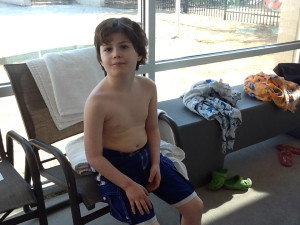 I have always dreaded Christmas Day. I like the holiday season…the houses look festive and people are friendly and parties abound. But, Christmas Day is usually pretty lonely feeling for me. I guess it goes back to the pre-text message and email days when the only way to reach people was to call their house phone or show up in person. Of course, calling or showing up at people’s houses on Christmas Day is not proper and I was taught at a young age to leave my Christian friends to their family time. In addition, just getting out and driving around on Christmas Day has an eerie feeling of post-apocalyptic solitude. That explains the age-old Jewish tradition of going to the movies and out for Chinese food. There is a sense of community in the crowded restaurants and theaters.
I have always dreaded Christmas Day. I like the holiday season…the houses look festive and people are friendly and parties abound. But, Christmas Day is usually pretty lonely feeling for me. I guess it goes back to the pre-text message and email days when the only way to reach people was to call their house phone or show up in person. Of course, calling or showing up at people’s houses on Christmas Day is not proper and I was taught at a young age to leave my Christian friends to their family time. In addition, just getting out and driving around on Christmas Day has an eerie feeling of post-apocalyptic solitude. That explains the age-old Jewish tradition of going to the movies and out for Chinese food. There is a sense of community in the crowded restaurants and theaters.
In recent years, even people who celebrate Christmas seem to have caught on to the idea of patronizing the only businesses that are open. Text messaging even makes it possible to set plans without worry of being disruptive. Unfortunately, until this year, our family was hit with the double dose of Christmas isolation. Having a child with autism can be isolating on any day of the year. But, on a dignified day like Christmas, it feels completely impossible to risk a bad scene when people’s options are so limited.
Christmas Day can feel like solitary confinement to a family whose child is prone to tantrums, maniacal laughter, aggression or generally unruly behavior. Unfortunately, these behaviors are quite common on days where the child’s schedule has been thrown off. Children with autism count on consistency and Gray counts on engagement from others to know what to do with himself.
About 4 years ago, we started the tradition of taking the kids to the Jewish Community Center for  swimming in the indoor pool. This is a great activity for burning an hour or two. Surprisingly, there aren’t many other people who act on this idea. We can generally count on a pretty open swimming pool with lots of room to splash around. This year was no exception. Even though Barry had stitches after he sliced his hand open while preparing a bagel for Gray, he bandaged it up and swam those kids hard. (He’s a good dad, but a terrible chef). Of course, after the swimming is done, there are still several hours to kill and hanging around the house isn’t a lot of fun when Gray is bored.
swimming in the indoor pool. This is a great activity for burning an hour or two. Surprisingly, there aren’t many other people who act on this idea. We can generally count on a pretty open swimming pool with lots of room to splash around. This year was no exception. Even though Barry had stitches after he sliced his hand open while preparing a bagel for Gray, he bandaged it up and swam those kids hard. (He’s a good dad, but a terrible chef). Of course, after the swimming is done, there are still several hours to kill and hanging around the house isn’t a lot of fun when Gray is bored.
Emboldened by Gray’s new affinity for dining out with Hope at his feet, I decided that this would be the year we try to return to the Chinese restaurant scene. Freshly showered and tired out from our swimming session, we showed up just as the restaurant was opening to ensure we got a table right away. My parents got to the restaurant ahead of us and secured a large booth in the back. It was the perfect set-up. The place quickly filled with patrons and I was delighted to see many familiar families. We had a great time. The food was fabulous and people we knew stopped by to chat. My kids tried foods I never thought they would.
Another family with small children sat at the table behind us. It was amusing to see the difference between their dining experience and ours. They had a two-year-old who kept squealing and crying and thrashing around throughout the meal. Meanwhile, Gray sat nicely and munched on an egg roll. My mother was so agitated with the other family that I had to laugh. She kept asking me if there might be something wrong with the child at the other table. “Why is their normal kid behaving so badly when your autistic son is able to sit so nicely?” Barry and I exchanged a chuckle. We both knew that we were just one dog (and a boatload of therapy) away from having a much worse scene at our table.
Of course, my favorite part of leaving a restaurant these days is the look on people’s faces when we get up from the table and a big black dog emerges from underneath. It’s hilarious to see the shock and hear the exclamations, “Oh my! I didn’t know there was a DOG in the restaurant! Isn’t that amazing!” It is amazing. I soaked in every step to the door that garnered a look of kindness or admiration from other diners and employees. We peacefully made our way through the crowd of hungry customers waiting at the front for a table to open. Gray and Hope easily navigated the crowd and a smiling man held the door for us to exit. We all stepped out into the brisk night with big smiles on our faces. We were all so happy. It was, indeed, a very merry Christmas!
How to Have an Easy Thanksgiving Day
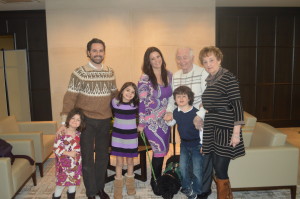 1. Skip the Turkey Trot
1. Skip the Turkey Trot
Every year, Barry likes to run the Turkey Trot. There are two races offered: the 5K and the 8 miler. Barry likes to run the 8 miler. In the past, it has been very helpful to me for him to remove Zoe and Gray from the house while I cook and get things set up for the Thanksgiving meal.
Unfortunately, as Gray has gotten older, he has become more and more difficult to manage in a jogging stroller. Let me first say that the jogging stroller was, for many years, the happiest place in the world for Gray. Even now, I find him sneaking into the garage and climbing into the stroller and just sitting there in the dark chewing on the seat belt straps. But, each year, complications arose that made it harder and harder to keep Gray and Barry happy. I think it was 3 or 4 years ago when we had a cold snap on Thanksgiving morning. It was just about 45-50 degrees that morning, so it didn’t seem like a big problem sending the boys out for the run. I just bundled Gray up with thick pants, socks, shoes and a blanket. He wouldn’t wear gloves back then (actually, he probably won’t now either), but I just told Barry to tuck the blanket tightly around him.
I think that may have been the hardest 8 miles that Barry ever attempted to traverse. Let me lay out the course for you. In years past, everyone starts the race at the same time and runs the same course for the first couple of miles. There are bands that play along the route and the crowd is quite thick. Just before the 3-mile marker, the course split and the 5K racers would turn back towards the finish line while the 8 mile racers peeled off to complete their remaining 5 miles. At that point, the crowd got dramatically thinner and the bands were much less exciting. I guess the entertainment value of the race wore off for Gray at that point and he needed to do something else to amuse himself. About a mile after the split, another runner caught up to Barry and handed him a shoe. Barry looked to down to see that Gray had removed his shoes and socks. Neither the socks nor the other shoe were anywhere in sight. Four miles down. Four to go. Turning back was not really an option as the course was winding through downtown and over closed highways. Barry decided to pick up the pace a bit. Within 10 minutes, Gray was screaming and thrashing in the stroller. He had the blanket wadded up beneath his legs and he was chewing on a corner leaving it soaking wet. As a result, the front of his shirt was wet as well. His uncovered hands and feet were bright red. Although, Barry stopped several times to readjust the blanket over Gray’s squirmy body, Gray wouldn’t keep it in place for more that a minute or two. Five miles down. Three to go. Barry picked up the pace again. The last 30 minutes of the race went something like this:
(Gray screaming and thrashing in the stroller.)
Well meaning runner: “Excuse me, but I think your son is upset because his feet are cold.”
Barry: “Yes, I know that. Thank you.”
Well meaning runner: “You know it’s pretty cold out here. I bet it’s windy in that stroller. You should put some shoes on him and cover him up.”
Barry: “Yes. That would be a good idea.”
(Awkward pause while the well meaning runner waits for Barry to stop and take care of his distressed child followed by the well meaning runner shaking his/her head and running on.) Some variation of that conversation was repeated with other well meaning runners at least two or three more times before the race was concluded.
As the years have progressed, Gray has gotten taller and fitting him in a traditional jogging stroller has become even more challenging. As Gray’s legs lengthened, he learned to take great joy in dipping his foot into the front wheel causing the whole stroller to come to a halt. This, in turn, would cause Barry to impale himself with the stroller handle. As Gray’s reach grew longer, his sneaky little hands would snake their way up the back of his seat and onto the the push handles where he would find Barry’s iPod and headphone cord. A quick jerk could easily rip the ear buds right out of Barry’s ears while Gray squealed and bounced in delight. Needless to say, Barry’s patience started wearing thin.
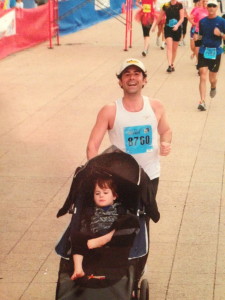 So, last year, we decided to purchase a jogging stroller for adults with special needs. The length was long enough to ensure that Gray could not pull any of his old tricks. The stroller arrived just before Thanksgiving and my parents graciously offered to prepare the turkey, so our entire family was free to participate in the Turkey Trot together. The weather was favorable, and we loaded up our new stroller for Gray and our old stroller for Lena and headed out for the race. I took the girls for the 5K race and Barry took Gray for the 8 miler. Things went beautifully for us girls and we waited at the finish line for Barry and Gray. As time ticked past, I grew concerned. When they finally chugged into view, I could tell by the look on Barry’s face that things had not gone smoothly. Two miles before the end of the race, the front wheel of the new stroller popped off sending Barry and Gray tumbling down. Fortunately, a new well meaning runner stopped to assist them.
So, last year, we decided to purchase a jogging stroller for adults with special needs. The length was long enough to ensure that Gray could not pull any of his old tricks. The stroller arrived just before Thanksgiving and my parents graciously offered to prepare the turkey, so our entire family was free to participate in the Turkey Trot together. The weather was favorable, and we loaded up our new stroller for Gray and our old stroller for Lena and headed out for the race. I took the girls for the 5K race and Barry took Gray for the 8 miler. Things went beautifully for us girls and we waited at the finish line for Barry and Gray. As time ticked past, I grew concerned. When they finally chugged into view, I could tell by the look on Barry’s face that things had not gone smoothly. Two miles before the end of the race, the front wheel of the new stroller popped off sending Barry and Gray tumbling down. Fortunately, a new well meaning runner stopped to assist them.
All this aside, we planned to attend the race again this year. That is, until we awoke on Thursday morning to find the temperature in the 30’s. Laying there in our cozy bed and considering the temperature outside, I’m certain that the exact same images flashed through both of our minds: waiting in the cold for the race to start, red cheeks and ears, whining and moaning about the wind, and all of the unknown calamities ahead. We quickly agreed to skip the race this year and turned on some cartoons for the kids while we burrowed in the covers.
2. Don’t cook or prepare a thing
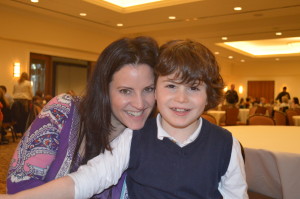 When I was a kid in my parents’ house, my mom always insisted on setting the table the night before Thanksgiving. We would pull out all of her best china and crystal and we would carefully lay a giant sheet over the whole table so it wouldn’t get dusty overnight. I laugh when I imagine a delicately-set table with a big sheet over it in my house. I’m fairly certain that there wouldn’t be one glass or plate intact by the time dinner was served. Additionally, putting on a Thanksgiving feast requires many hours of food preparation for at least 24 hours before the big event. Each year, I anxiously anticipate how Gray’s mood may or may not allow me to stand in the kitchen and prepare food with sharp knives and a hot oven and stove. This year, I luxuriated in the clean untouched kitchen and standard evening activities that took place on Wednesday night.
When I was a kid in my parents’ house, my mom always insisted on setting the table the night before Thanksgiving. We would pull out all of her best china and crystal and we would carefully lay a giant sheet over the whole table so it wouldn’t get dusty overnight. I laugh when I imagine a delicately-set table with a big sheet over it in my house. I’m fairly certain that there wouldn’t be one glass or plate intact by the time dinner was served. Additionally, putting on a Thanksgiving feast requires many hours of food preparation for at least 24 hours before the big event. Each year, I anxiously anticipate how Gray’s mood may or may not allow me to stand in the kitchen and prepare food with sharp knives and a hot oven and stove. This year, I luxuriated in the clean untouched kitchen and standard evening activities that took place on Wednesday night.
3. Go out for Thanksgiving Lunch
 For the first time ever, we all decided to go out for our meal. Honestly, now that we have Hope, it is easier to go out to eat than to stay at home. At home, Gray still can have a hard time sitting at the table for a meal. On his home turf, he feels entitled to roam about and cause destruction. He is actually offended and upset if someone tries to make him sit still for more than 15 minutes.
For the first time ever, we all decided to go out for our meal. Honestly, now that we have Hope, it is easier to go out to eat than to stay at home. At home, Gray still can have a hard time sitting at the table for a meal. On his home turf, he feels entitled to roam about and cause destruction. He is actually offended and upset if someone tries to make him sit still for more than 15 minutes.
Also, my kids are a lot like me. I like being around lots of people; especially on big holidays. For many reasons, that just isn’t a possibility in our house. By going out, we were guaranteed to be part of a festive environment with other like-minded families. It felt social and lively. Plus, the food was way better than anything I would have prepared. At least, the variety was way better. Just cite to the “Friends” episode when Monica had to make 5 different types of stuffing to satisfy everyone. It’s hard to be the lone cook and make everyone happy. The big buffet was brimming with lots of choices so everyone at my table was happy with their plate.
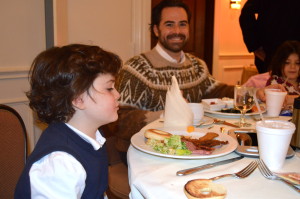 Walking up to our table, I felt a little concerned. Last year, our only option for Thanksgiving was to stay home with my parents as our only guests. The idea of going out in public to a nice restaurant wearing nice clothes and expecting to eat a leisurely meal would have been terrifying. It’s unbelievable to consider the change that Hope has brought in our ability to eat out. Still, this was our first venture into “fine dining.” I can only say that the day could not have gone more smoothly. We spent 2 1/2 hours on our leisurely and decadent meal. I was not strapped to the table at the mercy of other people to bring me a plate. Gray and Hope walked with me as we cruised the buffet for our favorite dishes. Gray didn’t even try to get up from his seat when I took myself to the buffet. At various intervals, we walked around, looked out the windows and greeted other guests. By the time dessert was over, Gray grew tired of his chair and just climbed into my lap. It was peaceful and lovely and I didn’t have to wash even one load of dishes.
Walking up to our table, I felt a little concerned. Last year, our only option for Thanksgiving was to stay home with my parents as our only guests. The idea of going out in public to a nice restaurant wearing nice clothes and expecting to eat a leisurely meal would have been terrifying. It’s unbelievable to consider the change that Hope has brought in our ability to eat out. Still, this was our first venture into “fine dining.” I can only say that the day could not have gone more smoothly. We spent 2 1/2 hours on our leisurely and decadent meal. I was not strapped to the table at the mercy of other people to bring me a plate. Gray and Hope walked with me as we cruised the buffet for our favorite dishes. Gray didn’t even try to get up from his seat when I took myself to the buffet. At various intervals, we walked around, looked out the windows and greeted other guests. By the time dessert was over, Gray grew tired of his chair and just climbed into my lap. It was peaceful and lovely and I didn’t have to wash even one load of dishes.
4. Spend the Afternoon Outside
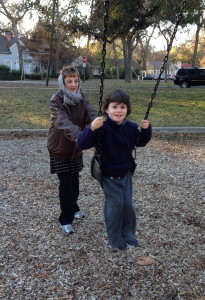 After lunch, we returned home and deposited Barry and my father on the couch to watch football. They were both asleep within 15 minutes. My mom and I loaded up the kids and headed to the park with Hope. The temperature had warmed up and we just needed light jackets. My mom pushed Gray on the swings while Zoe walked Hope on the path around the playground and Lena introduced herself to other kids. I took that moment to stop and breathe in the day. I was not frantic from an embarrassing scene, and I was not exhausted from trying to host the perfect day. I was happy and so was everyone else in my family. Life felt easy. What more could I ask for?
After lunch, we returned home and deposited Barry and my father on the couch to watch football. They were both asleep within 15 minutes. My mom and I loaded up the kids and headed to the park with Hope. The temperature had warmed up and we just needed light jackets. My mom pushed Gray on the swings while Zoe walked Hope on the path around the playground and Lena introduced herself to other kids. I took that moment to stop and breathe in the day. I was not frantic from an embarrassing scene, and I was not exhausted from trying to host the perfect day. I was happy and so was everyone else in my family. Life felt easy. What more could I ask for?
Gratitude
This week I attended a fundraising meeting for ASDA via Skype. The camera that gave me a view of the room was mounted up high and gave me a bird’s eye view of the other attendees. As everyone shared their ideas and took on tasks that would move us towards the goal of raising money, it struck me that I was looking down on a room of selfless people. Over half of the people on this fundraising committee are volunteers and the paid employees of ASDA do not have fundraising in their job descriptions. Everyone was there because we share the knowledge that the service dogs provided by ASDA are life changing and should be shared with many more families than are currently possible.
That got me thinking about all of the people that have entered our lives as a result of Gray’s autism. There have been countless therapists and therapy students and babysitters and volunteers that have shown us that the world is fundamentally good and filled with people that have a bottomless generosity of spirit.

 I’m thinking about Lauren, our first speech therapy student who answered my ad for extra help back when Gray was just 2-years-old. Lauren spent hours at my house working with Gray and brainstorming ideas to help him while weaving her way into our family. She would work with Gray whether he was in good spirits or bad. She didn’t run away when he drooled all over her or sneezed in her face or screamed for hours. She stuck with us and provided me with comfort and support. And, after she graduated, her sister Haley filled in to join our family as seamlessly as Lauren had.
I’m thinking about Lauren, our first speech therapy student who answered my ad for extra help back when Gray was just 2-years-old. Lauren spent hours at my house working with Gray and brainstorming ideas to help him while weaving her way into our family. She would work with Gray whether he was in good spirits or bad. She didn’t run away when he drooled all over her or sneezed in her face or screamed for hours. She stuck with us and provided me with comfort and support. And, after she graduated, her sister Haley filled in to join our family as seamlessly as Lauren had.
I’m thinking about our ABA therapists Tammy, Lorin, Lindsay, Jenny, Tatiana, Katy, and Niche. These ladies have been screamed at and pinched and wrestled with our screaming’ demon without complaint. I remember one evening a couple of years ago when Barry came home from work to find Lindsay at the table trying to get Gray to sit in his seat to eat his dinner. He was screaming and flailing and sliding out of the chair and she just calmly picked him up and 

 placed him back in front of his dinner plate. Barry found me in the back of the house and said, “Whatever she is getting paid, it is clearly not enough.” True. But, I have learned that these ladies, like all of the people who have joined our lives, are not looking to just make a paycheck. These ladies are deeply committed to helping my son because they see his potential and they feel a connection to him and our family.
placed him back in front of his dinner plate. Barry found me in the back of the house and said, “Whatever she is getting paid, it is clearly not enough.” True. But, I have learned that these ladies, like all of the people who have joined our lives, are not looking to just make a paycheck. These ladies are deeply committed to helping my son because they see his potential and they feel a connection to him and our family.
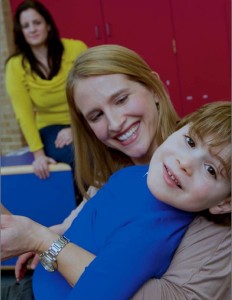 I’m thinking about our speech therapist, Jenny, who worked with Gray from the time he was 18-months-old and couldn’t swallow liquids or manage toddler foods and stayed with us all through the speech and language delays and into the present day despite the fact that behavior management is not part of her job as an SLP. She and all of the other therapists at Callier (Jamie and Jan) have been a source of information and reassurance for me as I navigate this unfamiliar territory. I’m thinking about the therapists who never gave up on Gray’s ability to operate the iPad for communication (Yvette, Lindsay, Melinda, Melissa and Carla) even when that meant hours of sitting in a bare room so that Gray could not look at anything but the iPad and the choices in front of him to help him understand the power of communication through a device.
I’m thinking about our speech therapist, Jenny, who worked with Gray from the time he was 18-months-old and couldn’t swallow liquids or manage toddler foods and stayed with us all through the speech and language delays and into the present day despite the fact that behavior management is not part of her job as an SLP. She and all of the other therapists at Callier (Jamie and Jan) have been a source of information and reassurance for me as I navigate this unfamiliar territory. I’m thinking about the therapists who never gave up on Gray’s ability to operate the iPad for communication (Yvette, Lindsay, Melinda, Melissa and Carla) even when that meant hours of sitting in a bare room so that Gray could not look at anything but the iPad and the choices in front of him to help him understand the power of communication through a device.
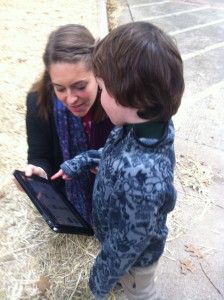
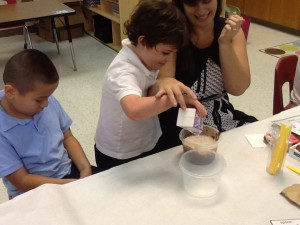
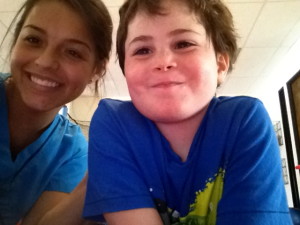 I’m thinking about the teachers Susan, Kendra and Jemarcus, who we all know are underpaid, but continue to pour their hearts into spending 40 hours a week with kids like mine to help them achieve their best. The teachers who spend difficult days with our kids and still find the energy to answer all of the questions and concerns for us parents truly deserve a medal.
I’m thinking about the teachers Susan, Kendra and Jemarcus, who we all know are underpaid, but continue to pour their hearts into spending 40 hours a week with kids like mine to help them achieve their best. The teachers who spend difficult days with our kids and still find the energy to answer all of the questions and concerns for us parents truly deserve a medal.
 I’m thinking of the babysitters who could easily find jobs caring for typical kids. These girls do not flinch when I warn them about pooptastrophes and Gray’s tendency to ingest non-food items. They don’t complain when they have to spend an unreal amount of time pushing Gray on a swing or jumping on a trampoline. I’m thinking about our INCREDIBLE nanny, Carolina. The hours that Carolina has spent sitting in therapy sessions to learn the best way to work with Gray, while still providing love to Zoe and Lena and order for our household are truly astounding to me. I’m thinking about the Sunday that she spent training with Kati and Hope so that she would get the best training possible to take Gray out in the community. When I tried to offer her extra pay for that day, she laughed at me and waived the money away. In her mind, Gray’s service dog was just as important to her as it was to anyone else in our family…of course she would come to the training without considering it “overtime.”
I’m thinking of the babysitters who could easily find jobs caring for typical kids. These girls do not flinch when I warn them about pooptastrophes and Gray’s tendency to ingest non-food items. They don’t complain when they have to spend an unreal amount of time pushing Gray on a swing or jumping on a trampoline. I’m thinking about our INCREDIBLE nanny, Carolina. The hours that Carolina has spent sitting in therapy sessions to learn the best way to work with Gray, while still providing love to Zoe and Lena and order for our household are truly astounding to me. I’m thinking about the Sunday that she spent training with Kati and Hope so that she would get the best training possible to take Gray out in the community. When I tried to offer her extra pay for that day, she laughed at me and waived the money away. In her mind, Gray’s service dog was just as important to her as it was to anyone else in our family…of course she would come to the training without considering it “overtime.”
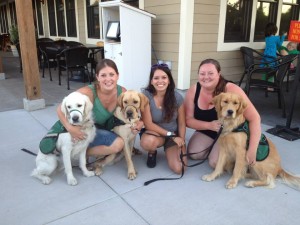 And, I’m thinking about all of the incredible people who make ASDA possible. The puppy raisers are all volunteers. They show up for monthly meetings to learn training techniques and they keep these precious animals in their homes for up to a year before releasing them to further their training and get placed with their new families. This is truly selfless work. When we went to Portland for camp this summer, almost the entire staff was made up of volunteers. There were autism specialists and puppy raisers and amateur trainers all there to help our service dogs get a “tune up” while the kids had a fabulous week. Kati and Laurel worked tirelessly to ensure that our kids with autism and our typical kids could share a camp experience that would be unavailable to other families like ours.
And, I’m thinking about all of the incredible people who make ASDA possible. The puppy raisers are all volunteers. They show up for monthly meetings to learn training techniques and they keep these precious animals in their homes for up to a year before releasing them to further their training and get placed with their new families. This is truly selfless work. When we went to Portland for camp this summer, almost the entire staff was made up of volunteers. There were autism specialists and puppy raisers and amateur trainers all there to help our service dogs get a “tune up” while the kids had a fabulous week. Kati and Laurel worked tirelessly to ensure that our kids with autism and our typical kids could share a camp experience that would be unavailable to other families like ours.

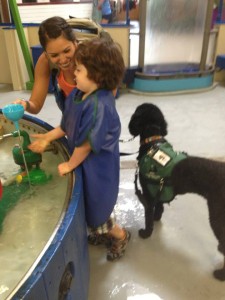 I’m sure that I have missed some of the people who should be included in this list. There really are so many people who have come to our aid over the years. The point is that, not one of them had to help us. Any one of them could have chosen a life in retail or restaurant management or some other more pleasant career. But, they didn’t. They chose to help us. For that, I am truly grateful.
I’m sure that I have missed some of the people who should be included in this list. There really are so many people who have come to our aid over the years. The point is that, not one of them had to help us. Any one of them could have chosen a life in retail or restaurant management or some other more pleasant career. But, they didn’t. They chose to help us. For that, I am truly grateful.



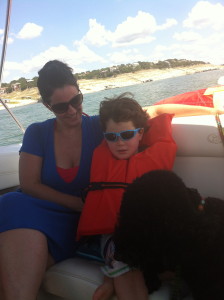
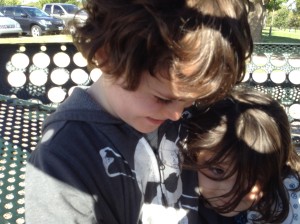





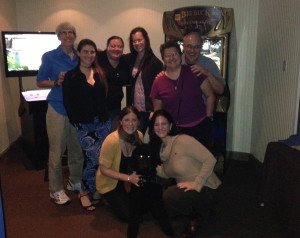
Recent Comments